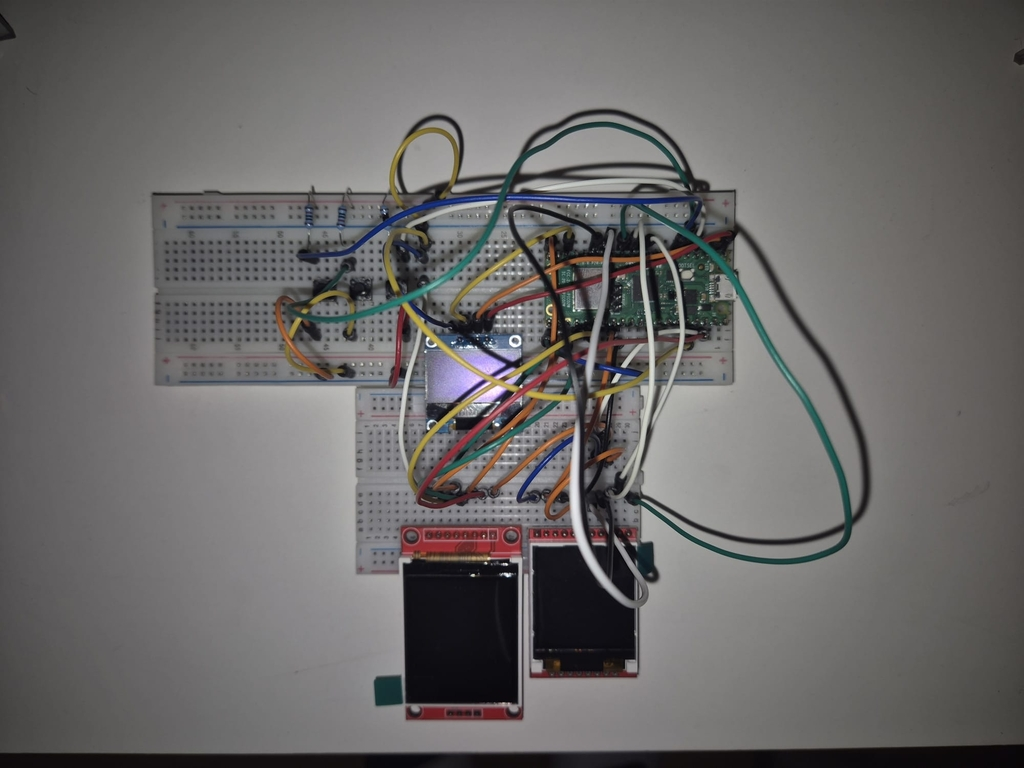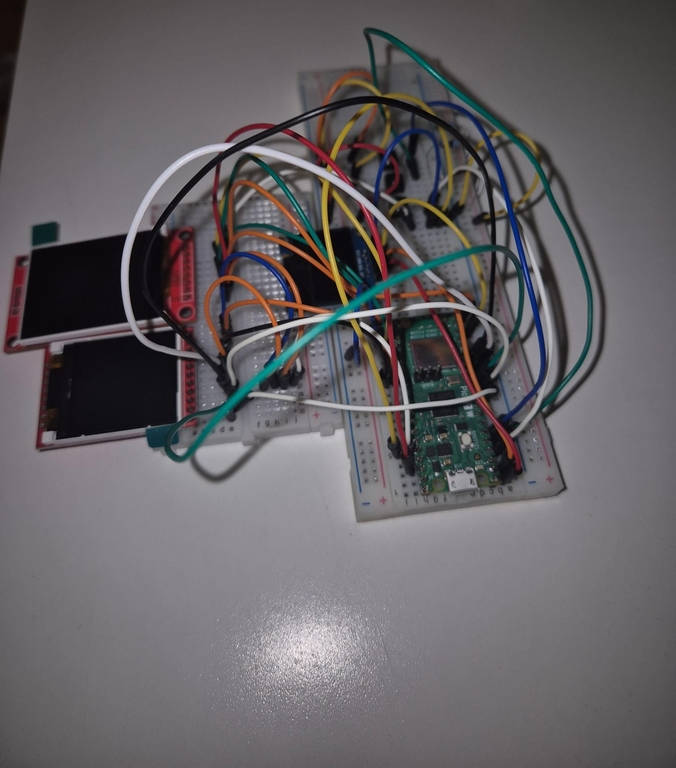Poker Game
A poker game against an AI using rust and the Raspberry Pi Pico 2
Author: Ciortan Rares-Sebastian
GitHub Project Link: https://github.com/UPB-PMRust-Students/project-troly69
Description
Pocket Poker is a single-player Texas Hold'em-style poker game that runs entirely on a Raspberry Pi Pico 2W, using a 1.8" SPI TFT LCD for the displays and push buttons for input. The game allows the player to go head-to-head against a simple AI dealer, simulating betting rounds, card dealing, and hand evaluation. All logic and graphics are written in Rust, demonstrating how embedded systems can be used for interactive, game-like applications without requiring internet or external screens.
Motivation
I wanted to create something more interactive and fun than traditional embedded projects. Poker is a great balance of logic, randomness, and user interface work. This project is a chance to explore Rust for embedded systems, work with SPI-based LCDs, and implement game logic on limited hardware.
Architecture
Raspberry Pi Pico 2W: Acts as the main controller. Runs the game logic written in Rust. Communicates with the displays via SPI and handles button input through GPIO. -Connection: Communicates with the display via SPI and handles button input through GPIO.
Buttons: Used for player inputs (Check,Bet,Fold). -Connection: Each button is connected to a GPIO pin with pull-down resistors for clean signals. Displays: Used to show the table cards, your cards, balance of both players/game state. -Connection: Connected via SPI (MOSI and CLK), plus control pins (CS, DC, RST).
Log
Week 5-11 May
In this week I mostly made the documentation, containing the description, motivation, architecture showing how it would work more or less, the start of the hardware section, bill of materials, list of software i might use, and some links to websites.
Week 12-18 May
This week I finished building the hardware, bought a few more items I needed and updated the documentation with the kicad schematic, a photo of the hardware built and added the hardware i bought to the bill of materials. I tested to see if the displays were connected properly and they were fine.
Week 19-25 May
For the last week, i started creating the software. It went well for the most part, but had a few issues with making the lcd displays work. In the end, with a bit of help, i managed to make them work, while still encountering some problems that I solved in the meantime. I pushed the code when i remembered, usually after making a big change or adding something important. Making the software for the poker game wasn't necessarily complicated, but it just took a long time, i spent basically all of my weekend and a few hours each day trying to make the game work. What i managed to make is a display that shows one of my cards, one that shows the other card, and the last one that shows the flop, turn and river cards when i press the check button. at the end of the turns, the opponent(programmed him to recieve cards too) would have his hand revealed on the display, and in vscode I show the pairs we each had, who won and what ammount of money bet you recieved. I made three types of buttons with different functions: the CHECK button witch I already talked about, the BET button which allows me to bet a fixed amount of money and a fold button, which basically starts a new game. Also the money you have in the bank remains in between games, until you restart the software.
Hardware
The hardware consists of a raspberry pi pico 2W microcontroller as the core unit, around 3 displays used for displaying the cards, balance etc. , buttons for checking, folding, betting.
Schematics



Bill of materials
| Device | Usage | Price |
|---|---|---|
| Raspberry Pi Pico 2W | The microcontroller | [40 RON] |
| Wireless Super Starter Kit with ESP8266 (Programmable with Arduino IDE) | Kit | [65 RON] |
| Modul LCD SPI de 1.8"(128x160) | LCD Display | [29 RON] |
| Ecran OLED 0.96" cu interfata IIC/I2C | OLED Display | [19 RON] |
| LCD de 1.44'' pentru STC, STM32 și Arduino (5 V) | LCD Display | [35 RON] |
| [Breadboard] | Connectivity | in kit |
| [Buttons] X3 | Game Inputs | in kit |
| [Jumpers] | Connectivity | in kit |
| [Resistors(10K)] | Connectivity | in kit |
| breadboard HQ | Connectivity | [5 RON] |
| Raspberry Pi Pico | Debugger | [23 ron] |
| TOTAL: 225 RON. |
Software
| Library / Tool | Description | Usage |
|---|---|---|
rand | Random number generation | Used to shuffle the deck with entropy from GPIO and time |
embassy-rp | Hardware Abstraction Layer for the RP2040 | Access to SPI, GPIO, timers, clocks, etc. |
embedded-hal | Embedded hardware abstraction traits | Interface between display/button drivers and hardware |
panic-probe | Panic handler that logs panics with defmt | Ensures panics are displayed via defmt instead of crashing silently |
embedded-graphics | 2D graphics library for embedded displays | Draws text, shapes, cards, etc. on screen |
defmt | Lightweight logging framework for embedded systems | For logging debug messages (e.g. hand results, chip updates) to the terminal via info! |
defmt-rtt | Real-time target transport for defmt logs over RTT | Enables defmt logs to be printed during runtime on the host |
embassy-time | Async timers for Embassy framework | Used for timing delays (e.g. waiting between game stages or animations) |
embedded-time | Time units and delays for embedded | Used for timing animations or button debounce |
embassy-sync | Mutexes and sync primitives for shared peripherals | Used to share the SPI bus safely between tasks |
| 'embassy-embedded-hal' | Adapters for using Embassy with embedded-hal | Provides shared bus support for SPI with SpiDevice |
| ssd1306 | Driver for SSD1306 OLED displays using I2C | Controls your OLED screen to display game state (cards, messages) |
| mipidsi | Driver for MIPI-compliant displays like ST7735 | Controls the two ST7735 SPI LCD screens to show player cards |
| heapless | Provides Vec, String, etc., without dynamic memory | Used for storing cards, formatting text, and tracking hand ranks without a heap |
Links
- [Texas Hold'em rules] (https://casinos.lotoquebec.com/dam/jcr:c49e36e5-1e3d-4123-ae10-e7250d837140/Regles_Ultimate-Texas-Holdem_e.pdf)
- [embedded-graphics] (https://github.com/embedded-graphics/examples)
- [Rust on Raspberry Pi Pico Guide] (https://github.com/knurling-rs/app-template)